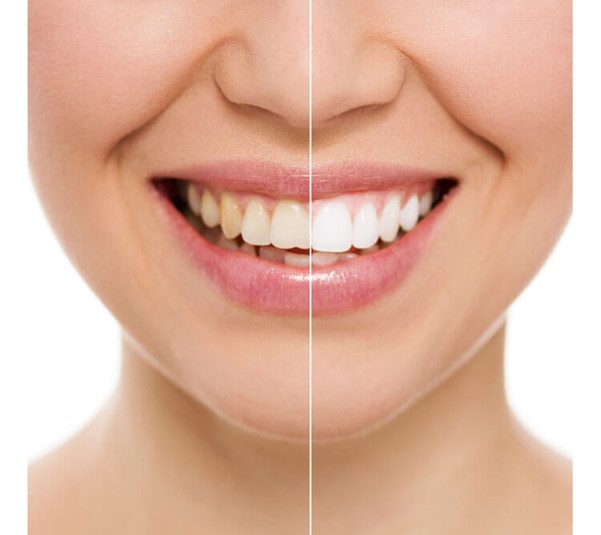Solutions To Common Dental Problems
Discoloured or Stained Teeth
Do you have stained or discoloured teeth?
In time your teeth will change colour – they may appear yellow or grey or even have tinges of orange, black and brown.
Discolouring can affect the outer surface of your teeth or the inner part of the tooth. It's important to know which type of staining you have so the right treatment can be applied.
You don’t need to live with teeth stains or discoloration – there are ways to brighten your smile and get that fresh look.

Causes of Teeth Discoloration and Staining
There are a number of reasons why teeth may discolour or stain. These include:
Age & Genetics
- Age can wear away at the enamel exposing yellowness of the dentin. this can also be expedited when using abrasive toothpastes and tooth brushes
- Genetics - your teeth, hair and skin come from the same embryonic germ layer. This means that you have a predisposition for the colour of your teeth, or in other words how white - or yellow your teeth are is predetermined. These are later influenced by environmental conditions as the tooth develops.
Lifestyle
- Smoking - tobacco use can also cause your teeth to change colour over time causing a brown hue.
- Dark coloured drinks such as tea and coffee and certain alcoholic drinks (red wine)
Dental
- Mouth washes that contain certain chemicals such as chlorhexidine can lead to the brown staining of teeth.
- Certain dental materials such as silver amalgams can create bluey grey hue across teeth
- Excessive fluoride (high usage) can causes fluorosis which are white spots or a mottled appearance. The source is excessive ingestion of fluoride such as fluoride supplements, fluoride rinses or toothpastes
- Braces and other orthodontic treatments
- Excessive brushing - where tooth enamel may be removed and dentine's yellow hue will shine through
- Poor oral hygiene. Infrequent brushing and flossing leads to plaque build-up and calculus forming. This means the foods and beverages you consume that are staining are not being removed from the surface of your teeth. Over time, this causes the tooth's enamel to change pigmentation and brushing alone may not be able to remove the staining and discoloration.
Trauma/Injury
- Trauma or injury to the teeth - where damage to the tooth's pulp and bleeding can lead to tooth discoloration
It is also important to note the role that tooth decay plays in discolouring and staining your teeth. Tooth decay can vary from orange to brown to black. As enamel is transparent, the colour of the dentine (which has been impacted by the bacteria) shines through. Furthermore, advanced tooth decay creates cavities (a hole) where food debris collect. Within the cavity bacteria colonises and in addition with the stains from foods and drinks, the teeth change colour.
FAQs about Discoloured or Stained teeth
Yellow and stained teeth can occur for a number of reasons. These may include:
- Aging
- Certain food – oranges, berries
- Certain drinks – red wine, coffee
- Smoking
- Poor dental care
- Thin enamel
- Certain medications
- Trauma and internal bleeding of a permanent tooth
- High fluoride levels
When it comes to yellow, discoloured and stained teeth, prevention is better than cure. But in most cases, brightening a smile or reversing a stain or discoloration is within your reach.
There are a number of treatment options available for yellow, stained and discoloured teeth.
It is important to speak with a dentist to determine why you have discoloured teeth. This will also ensure you get the appropriate treatment for your individual circumstances.
- Maintain good oral hygiene – brush and floss your teeth daily. This will eliminate plaque build up and reduce the onset of discoloration
- Modify your diet and lifestyle choices
- Have regular checkups and dental cleanings and polishing
- Visit your dentist for teeth whitening treatments

Preventing Discolouration and Teeth Staining
The discolouration of teeth is relatively common but also preventable. Maintaining good oral hygiene is important such as:
- using floss or interdental brushes
- brush twice a day
- having regular check-ups
- having regular professional dental cleanings
- rinse your mouth after consuming food or drink to remove food particles
You may also be a good idea to cut down on what may be staining your teeth – such as certain foods or drinks.
There are many methods to counter discoloured or stained teeth. The best method is to maintain good oral health, make the right lifestyle choices and have your teeth reviewed with regular checkups and professional cleans.
Intrinsic and Extrinsic Stains
Discoloration or staining can be defined as being either intrinsic or extrinsic. The differences are:
- Intrinsic staining - is where the stain is imbedded within the tooth and more difficult to remove. These are caused by trauma and injury, caries (tooth decay) or medications. Some intrinsic stains may have been formed during pregnancy.
- Extrinsic staining refers to on the surface staining. The discoloration or staining is generally superficial.
Treatment for Discoloured or Stained Teeth
The obvious treatment option is teeth whitening. Depending on the intensity of the stain and colour, you may opt for whitening toothpastes, over the counter whitening products or have your teeth professionally whitened by the dentist.
Professional whitening of your teeth can be done via a take home kit or in the dental chair. The advantage of professional whitening is that it uses a bleaching agent (hydrogen peroxide) which can remove not only extrinsic stains but also those difficult to budge intrinsic stains.
Other treatment solutions include:
- veneers - this is where the discoloration can be masked by applying a thin layer of filling material to disguise the colour and reshape your tooth
- crowns and white fillings
- professional dental cleaning - help to reduce the build up of plaque and tartar and coincidentally minimise the emergence of stains and discoloration.
Transform Your Smile At Woodville Seaton Dental Clinic
The discolouration of teeth is relatively common but also preventable and treatable.
A visit to the dentist can help identify the causes of the tooth discolouration and stains and provide solutions to prevent further damage.
Don't let stained and discoloured teeth hold you back from that radiant smile. Regain your confidence with an amazing smile.
To find out more about treating your discoloured or stained teeth, call our friendly staff at Woodville & Seaton Dental Clinic on (08) 8268 5422 or request an appointment online.
